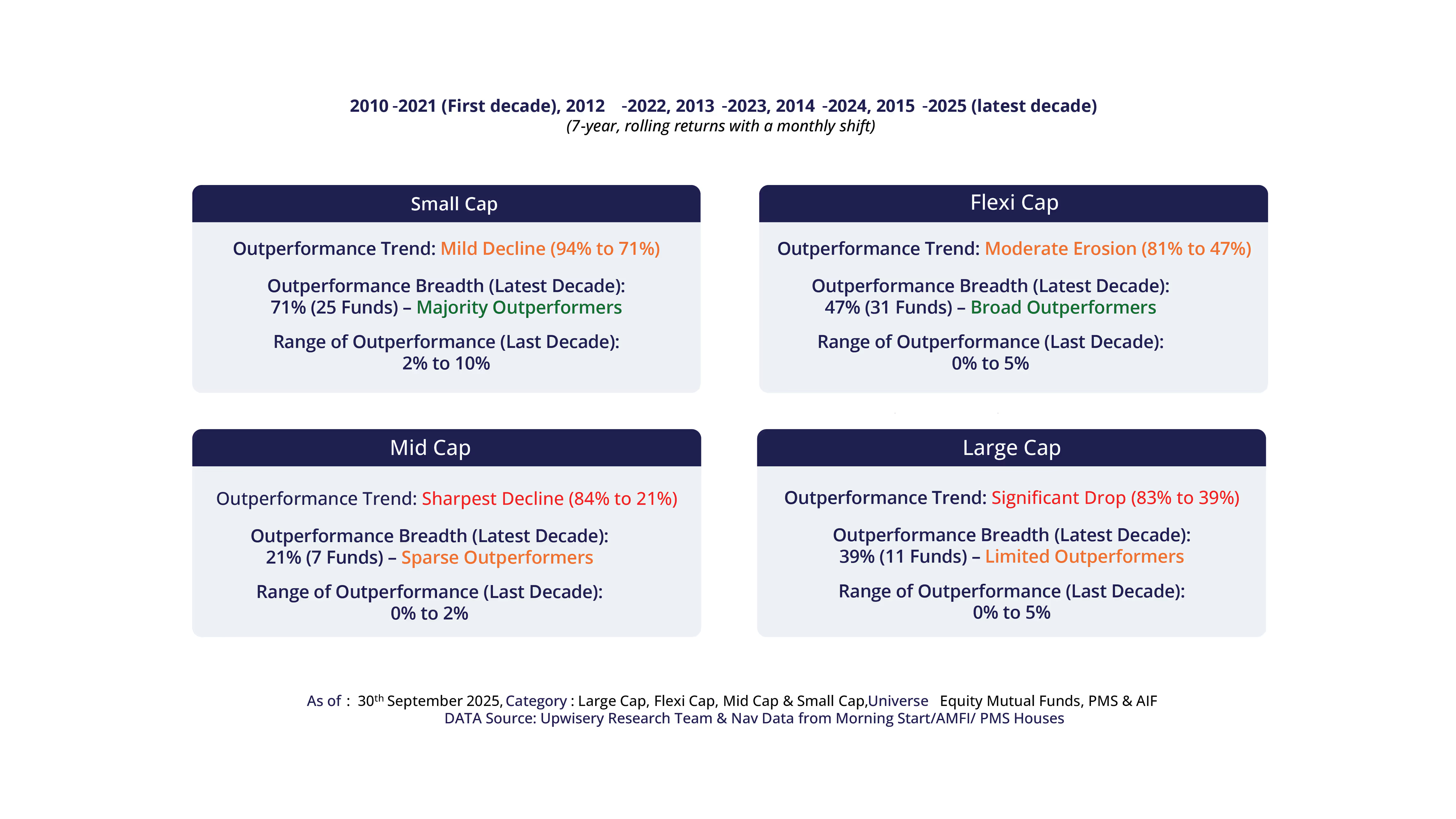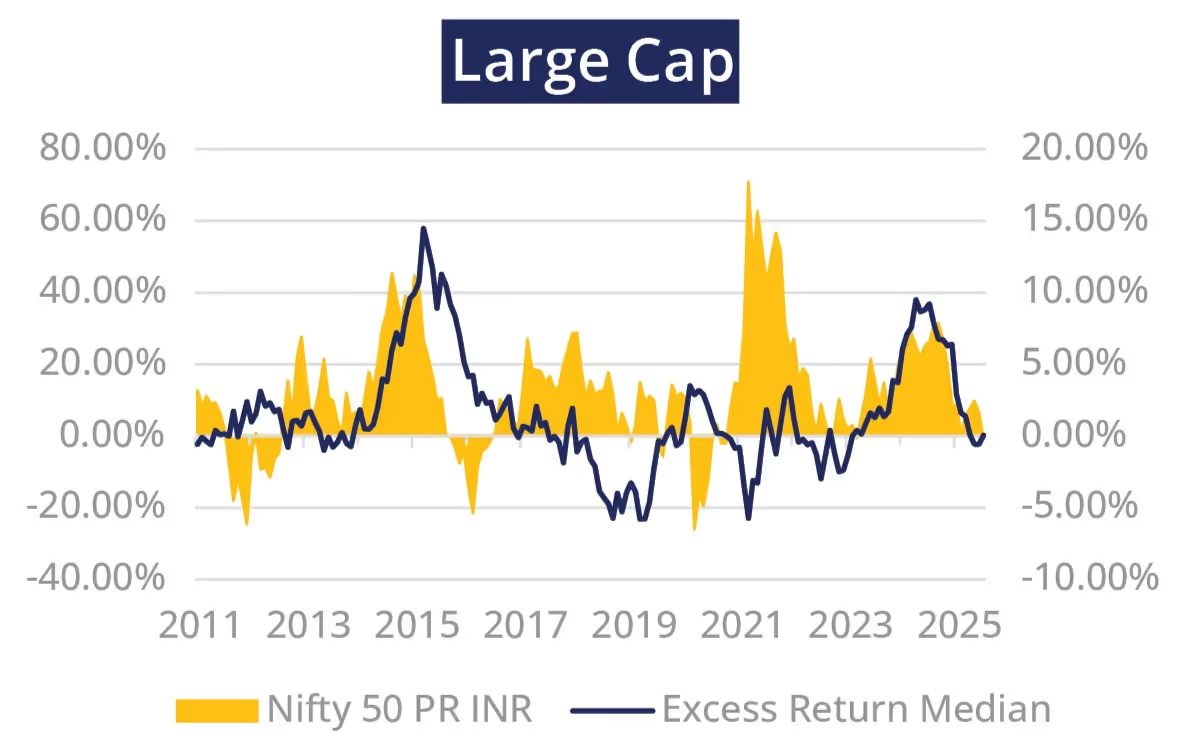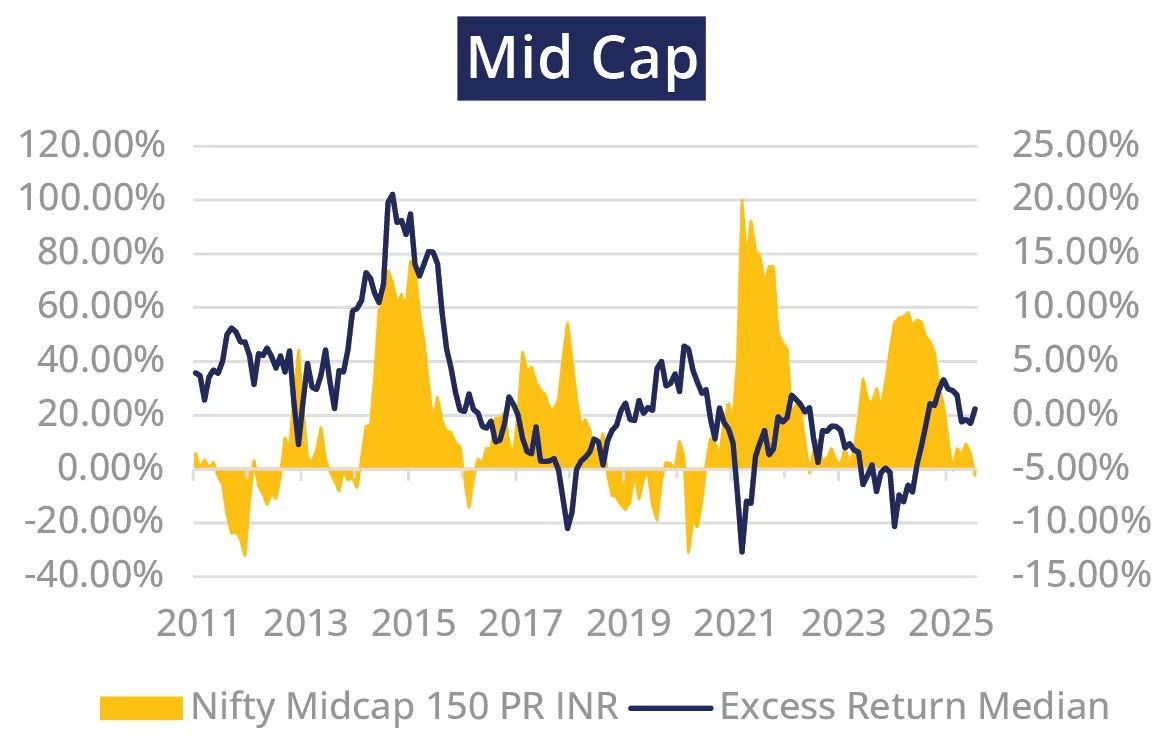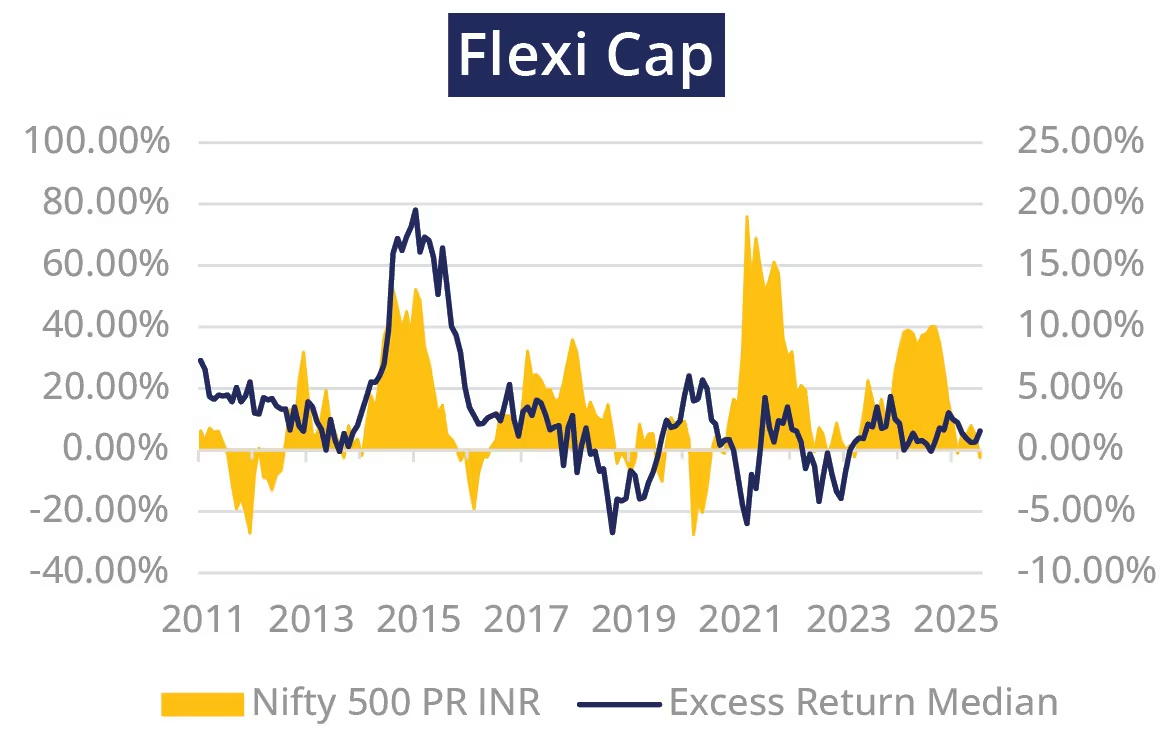


Your Wealth Wisely























Your Wealth Wisely
















Your Wealth Wisely









This analysis examines seven years of rolling returns across multiple market capitalizations in Indian equity markets, revealing significant divergence in active management effectiveness across segments. The data shows that active management's ability to generate consistent alpha has become increasingly segment-dependent, with large-cap and mid-cap strategies facing substantial headwinds while small-cap approaches continue demonstrating meaningful value addition. Concurrently, factor-based indices have emerged as systematic alternatives, delivering superior risk-adjusted returns across market conditions.

The rolling seven-year returns across major indices reveal important structural shifts. The Nifty 50 has delivered CAGRs ranging from 12.9% to 17.7%, with the most recent decade showing moderation to 12.9%. The Nifty 500 has demonstrated greater consistency at 11-13.5%. Most notably, the Nifty Midcap 150 has emerged as the standout performer in the latest decade, delivering 17.2% CAGR compared to the Nifty 50's 12.9%—a fundamental shift where mid-sized companies have seized market leadership.
The small-cap segment has shown progressive improvement, with recent returns of 14.2% marking significant acceleration from the 11.6% delivered in 2010-2020, suggesting growing market depth and improved liquidity in smaller capitalization stocks.

Against this backdrop, active management success rates have diverged dramatically: small-cap maintains relative resilience (decline from 94% to 71%), flexi-cap shows moderate erosion (81% to 47%), large-cap faces significant challenges (83% to 39%), while mid-cap has suffered the sharpest collapse (84% to 21%).

The large-cap segment demonstrates a clear pattern of declining active outperformance. The fund universe has remained relatively stable at 24-28 funds, yet outperforming funds have declined from 20 (83%) to just 11 (39%). The excess return distribution has shifted decisively toward the 0-2% bucket, where eight of eleven outperformers now cluster. The 5-10% excess return bucket, which housed six funds in 2010-2020, has vanished entirely by the latest period.
Several structural forces, which continue to strengthen, explain this pattern:


The cyclical analysis shows large-cap active management has evolved from consistent alpha generation to selective positioning. Excess returns have largely faded post-2017, with funds mirroring benchmarks during rallies but showing mild outperformance during corrections.


The mid-cap segment presents a striking paradox: exceptional index returns (17.2% latest decade CAGR) coinciding with dramatic active underperformance. Outperformance rates have declined from 84% (21 of 25 funds) to just 21% (7 of 33)—the sharpest decline across all segments.
The excess return distribution reveals concerning trends. The 2-5% bucket, which housed 15 funds in 2010-2020, now contains just 1 fund. The 5-10% bucket has collapsed to zero. The 0-2% bucket now dominates with 6 of 7 outperforming funds, representing minimal outperformance.
This occurred as mid-cap indices delivered their strongest performance, suggesting broad-based expansion drove returns. Contributing factors include: valuation compression as the segment attracted flows, index concentration in quality winners, liquidity constraints pushing funds toward larger mid-caps, rapid sector rotation, and momentum dominance.

Excess returns have eroded since 2018, with performance becoming highly cycle-dependent. Active managers show shorter bursts of relative gains post-correction (3-6 months versus historical 12-18 months), compressing opportunity windows.


The flexi-cap category has experienced robust growth from 42 to 66 funds, while success rates declined from 86% peak to 47% currently. However, the absolute number of outperforming funds has remained stable at 31-38, suggesting talent dispersion rather than universal skill erosion.
The excess return distribution reveals bifurcation: the 0-2% bucket has expanded to 17 funds, while meaningful alpha clusters persist—9 funds in 2-5% bucket, 5 funds in 5-10% bucket.
Notably, flexi-cap outperformance appears cyclical: rates peak during periods encompassing corrections (86% in 2011-2021) and decline during extended rallies (47% in 2015-2025), aligning with the thesis that active managers add value when reallocating across market caps during dislocations.


Excess returns exhibit pronounced cyclicality, improving during corrections and narrowing during uptrends. During stress, value emerges through market-cap rotation, cash management, and quality concentration. During rallies, flexibility loses edge as segments move in tandem.


Small-caps stand in stark contrast to other segments, maintaining robust active outperformance despite near-doubling of the fund universe from 18 to 35. Success rates show only mild decline from 94% to 71%, with 25 funds currently outperforming—more in absolute terms than existed a decade ago.
The excess return distribution remains compelling: 11 funds in 5-10% bucket, 11 funds in 2-5% bucket, and only 2 funds in 0-2% bucket. One fund continues delivering >15% excess returns, indicating skilled small-cap managers reliably deliver mid-to-high single-digit annual alpha.
Structural factors explain this resilience: sparse analyst coverage creating information asymmetries, behavioral inefficiencies (momentum, mean-reversion, sentiment extremes), illiquidity premiums favoring patient capital, corporate action complexity (demergers, acquisitions, restructurings), and micro-cap extension beyond benchmark constraints.

Small-caps demonstrate distinctive counter-cyclical alpha: excess returns increase when indices fall and compress (but remain positive) during rallies. This reflects micro-cap rotation, expanding dispersion during stress, widening liquidity premiums, and forced-seller dynamics. Critically, active managers maintain positive excess returns even during rallies, demonstrating structural rather than purely cyclical alpha generation.


Factor-based indices have demonstrated compelling performance characteristics relative to both traditional active management and market-cap weighted benchmarks.
Momentum dominance: The Nifty Midcap 150 Momentum 50 achieves exceptional performance: 26.88% median 3-year returns, 1.25 Sharpe ratio, and zero negative 5-year periods. The Nifty 500 Momentum Quality 50 delivers 20.25% median returns with 1.16 Sharpe, blending momentum's return potential with quality's downside protection. The Nifty 200 Momentum 30 provides 20.46% returns with 0.95 Sharpe.
On 3-year rolling windows, Nifty100 Low Vol 30's worst period was -3.5% versus roughly -6% to -22% for broad cap-weighted indices, highlighting defensive characteristics during market stress.
Comparative performance: Factor indices deliver Sharpe ratios of 1.16-1.25 versus 0.70 for Nifty 50, with minimal negative instances (0-1% over 5 years) versus higher dispersion in active funds. Cost structures of 0.30-0.50% versus 1.5-2.5% for active funds create meaningful expense differentials.


The analysis reveals a bifurcated landscape across market capitalizations:
Large-cap: Characterized by high efficiency, with only 39% of active funds outperforming and excess returns compressed to 0-2%. Current regime shows early recovery with negligible active-passive forward return differential (20 basis points).
Mid-cap: Exhibits the sharpest decline in active effectiveness, with just 21% outperforming despite strong index performance of 17.2% CAGR. Index leads forward expectations by 4.3 percentage points, indicating beta dominance. Factor alternatives, particularly Nifty Midcap 150 Momentum 50, demonstrate superior risk-adjusted returns (1.25 Sharpe ratio).
Flexi-cap: Shows moderate erosion with 47% success rate but demonstrates cyclicality, with outperformance improving during corrections. The 7 percentage point forward spread merits monitoring, though current early recovery regime historically favors beta capture.
Small-cap: Maintains robust active outperformance with 71% success rate and meaningful excess returns (2-10% bucket concentration). Forward expectations show 13 percentage point active advantage, indicating persistent structural inefficiencies supporting active management.
Factor strategies: Momentum-based factors demonstrate best-in-class performance with Sharpe ratios of 1.16-1.25, substantially exceeding both market-cap indices (0.70) and typical active funds. Quality and low-volatility factors provide defensive characteristics with equity-like returns.
The Indian equity landscape demonstrates clear segmentation in active management effectiveness. Large-cap and mid-cap segments show declining active outperformance rates (39% and 21% respectively) with compressed excess returns (0-2% concentration), coinciding with structural efficiency increases. Small-caps maintain significantly higher active success rates (71%) with substantial excess returns (2-10% range), reflecting persistent structural inefficiencies.
Factor-based indices have emerged with distinctive performance characteristics: momentum factors deliver 20-27% median returns with 1.16-1.25 Sharpe ratios, substantially exceeding traditional benchmarks. Quality and low-volatility factors provide defensive positioning with reduced drawdown characteristics.
The current regime analysis places all segments in early recovery, with varying forward return differentials: large-cap shows minimal active-passive spread (20 bps), mid-cap shows index leadership (-4.3 percentage points), flexi-cap shows moderate active advantage (+7 percentage points), and small-cap demonstrates substantial active advantage (+13 percentage points).
These patterns suggest segment-specific approaches reflect underlying market structure differences, with efficiency levels, information availability, liquidity characteristics, and institutional participation varying meaningfully across market capitalizations.
Small-cap: Maintains robust active outperformance with 71% success rate and meaningful excess returns (2-10% bucket concentration). Forward expectations show 13 percentage point active advantage, indicating persistent structural inefficiencies supporting active management.